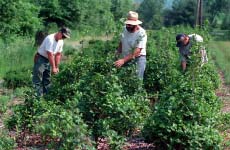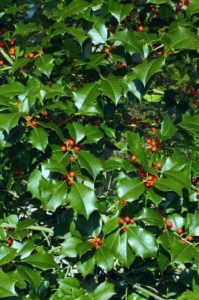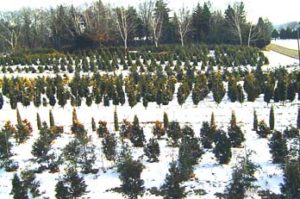HYBRID AMERICAN HOLLY FLOURISH AT BUTLER NURSERY
Saturday, June 12, 1999
By Susan Banks, Post-Gazette Staff Writer

JOYCE MENDELSOHN/POST-GAZETTE
If things had gone according to plan Charles Hinchberger and Bob Yates wouldn’t be in the nursery business. But fate has a funny way of determining these things, and both men, after careers in other fields, are back on the farm.
Amid 40 acres of fields in Butler County, they operate the Orlando S. Pride Nurseries. Hinchberger, who owns the place, is a soft-spoken man. He doesn’t say much except to point out plant specimens he particularly likes or dislikes during a cool morning walk of the acreage. Hinchberger clearly knows what he’s about, in that quiet authoritative way of someone who cares about his work but doesn’t feel compelled to broadcast it. What he doesn’t say speaks volumes.
Yates, meanwhile, is not afraid to crack wise with somebody he’s never met. But he’s still clearly happy out in the fields, too. Both men are a delight in their own distinct ways, but that’s not unexpected, because they and their business come highly recommended. Peggy Rea, one of the most extraordinary gardeners I know, wrote me a couple of years ago and told me that I must visit this out-of-the-way place. It’s taken two years, but I finally made it. And Peggy is right.
Hinchberger took over the old Orlando S. Pride Nurseries in 1987. The nursery was established in 1928 by Pride, who made a name for himself in the horticulture world by hybridizing holly. Sometimes called “Mr. Holly” Pride is credited with extending the northern-most range of holly or Ilex more than 500 miles by his judicious breeding program. Pride also dabbled with rhododendrons and many other types of plants. He owned and operated the nursery until his death at the age of 78 in 1983.
Hinchberger, who had known and worked for Pride while he was still in high school, felt strongly that the nursery name should stay in place to honor the great plantsman. and the nursery still specializes in the hollies that Pride worked on during his lifetime. Today, holly plants from the Butler fields are shipped all over the United States.
Yates joined the operation six years ago and works as nursery foreman. Hinchberger, Yates and one other employee run an operation that encompasses 40 acres at the nursery, and 23 acres elsewhere in the country.
Hinchberger says the nursery is primarily a production nursery where orders are custom-dug, but they do have a small retail operation offering a selection of perennials, trees and shrubs, especially the Holly (Ilex) “Grace” hybrids that Pride developed.
American Holly are popular now because these handsome plants are also deer-resistant, a big attraction in Allegheny County where the deer population has skyrocketed in recent years.
But the nursery carries other plants too, and customers are encouraged to walk around to see mature specimens of many types of trees and shrubs, most planted when Pride as still in charge.

Among the plants that the men encourage area homeowners to plant are the hollies, of course, Sweet Bay Magnolia (Magnolia virginiana); Bottlebrush buckeye (Aesculus parvifora); and Aesculus pavia or Red Buckeye, which matures into a ornamental-sized tree and has red blooms that are especially attractive to hummingbirds. They also like Oakleaf hydrangea, Viburnum ‘Mohawk’ — which has beautiful pink flowers and nice fall color, too — and White Fringetree (Chionanthus virginicus), which both men say are magnificent trees for this area.
Besides selling plants, the men are involved in testing many varieties, evaluating chamaecyparis, boxwoods, hemlocks and rhododendrons for size and winter hardiness. Hinchberger particularly likes green chamaecyparis because they never seem to have problems with insects or disease and are pretty good general-purpose plants.
Like Pride, Hinchberger also dabbles with rhododendrons. Pride had several hundred cultivars of rhododendrons on the property, and many are still there. While Pride bred plants primarily for flower color, Hinchberger puts emphasis on overall appearance, along with flowers.
Another plant both are extremely fond of are Japanese tree lilacs (Syringa reticulata). Hinchberger says they are wonderful plants because, unlike their native counterpart the common Syringa vulgaris, they don’t need to be pruned, aren’t bothered by borers and don’t suffer from powdery mildew disease, which disfigures the leaves. They are carefree plants in the best sense, since they can be planted and left alone.
Since the nursery specializes in balled and burlapped specimens, customers may not be able to take home plants the same day they buy them. And if they purchase a holly, they’ll have to wait until late summer, which is the best time to transplant this plant.
The Orlando S. Pride Nurseries are located at 145 Weckerly Road, off Route 8 north, before Butler. Retail hours are 8 a.m. to 4 p.m. Fridays and Saturdays. On Mondays through Thursdays, call for an appointment at 724-283-0962. The nursery is closed Sundays.
 Sometimes people referred to Orlando Pride as “Mr. Holly,” but he never minded. He spent almost six decades growing and testing that ancient tree on his Butler experimental farm, and became one of the only 10 hybridizers in the entire country.
Sometimes people referred to Orlando Pride as “Mr. Holly,” but he never minded. He spent almost six decades growing and testing that ancient tree on his Butler experimental farm, and became one of the only 10 hybridizers in the entire country.
His romance with holly came about by accident. As a pre-med student at Penn State, a fraternity brother happened to be studying landscape design. He showed Mr. pride his first American holly growing wild in the mountains of West Virginia. From then on, that was it.
HYBRID TREES
Mr. Pride forgot about a career in medicine. “You should see me fuss over a tree or plant that’s sick. How do you think I could have survived a lifetime as a doctor?”
Seventy years ago, Mr. Pride couldn’t understand why holly trees didn’t show up in home gardens. He still couldn’t understand why his favorite tree did not become popular sooner.
We’ve got a hardy variety now. And the holly is lush and green all winter long – with red berries. These stay on all winter until the robins come back in the spring – then you should see them feast. They love to nest in holly too – the sharp leaves are natural defense against cats.
Mr. Pride’s city garden in Butler had stunning holly trees, some the result of the original seeds given to him years ago by his fraternity brother.
He spent much time at his farm five miles south of town, where he cultivated rows of the glossy green holy in different stages of growth. He specialized in his own strains, carefully developed from the original rugged West Virginia type. He called them Grace hybrid hollies – named for his wife, Grace Elizabeth (Betty) Pride. He developed 16 varieties
One thing holly taught the quiet, soft spoken horticulturist was infinite patience. “Nothing hurries holly,” he said. “It’s slow growing, but strong. And some varieties have produced trees 85 feet tall and three or four centuries old.”
Such magnificent specimens were in Mr. Pride’s dreams, no doubt, when he planted his 20,000 seedlings years ago on his grandfather’s farm, which grew into Pride Nursery.
SLOW GROWER
“We fought off the mice and birds but two years later we had weather 32 degrees below zero. I’ll never forget walking along that field looking at all those frozen hollies. We were wiped out – all but 2000 – and of these only 25 were a good strong healthy green – well shaped, too.”
These 25 survivors formed the basis for Mr. Pride’s hybridizing work. He began corresponding with holly experts all over the world, and even imported holly seed from the most northern parts of Norway. The idea was to get a holly that could stand our severe winters. English holly doesn’t do well here because it likes the slower seasonal changes and milder weather in England. It also loves foggy weather.
There might be something to the theory that producing a fine holly under conditions of complete neglect might provide a hardier plant, but the time element makes the whole thing difficult. Orlando Pride took almost 40 years in developing holly hybrids. That’s probably one reason there haven’t been more workers in the holly vineyard.
It takes about 15 years to see whether a hybridized holly is going to amount to anything. But once a good variety is discovered, you have something of value. Mr. Pride referred to his “Clarissa” as one of the surviving plants from the big freeze of 1933. It was one of the seedlings that didn’t do so well. But we left in in the field and it seemed to stand still for years. Then we transplanted it with some others into a heavily fertilized field and the change was remarkable.
It just came to life.
Cuttings from this original tree went to the U.S. National Arboretum and were seen by Dr. Richard Meriam of Harvard University. He thought it to be one of the finest hollies of its type. Just imagine if it had been overlooked. Mr. Pride grew practically every kind of holly in his experimental gardens, but many could not stand our harsh winters. Butler’s Western PA temperatures are as varied, and can be as severe, as temperatures into Maine and Canada.
SACRED PLANT
Mr. Pride devoted his life to hybridizing holly because he loved the outdoors and it satisfied him to work on something he knew beautified the world. Hybridizing was exciting as he never knew what the result would be. Holly is an ancient plant with a long and exciting history. Mr. Pride felt it shouldn’t be neglected in his current and commendable rebirth of interest in home landscaping. The ancient Druids of the British Isles considered holly sacred and there were 500 holly varieties in the world – and many opportunities for legends. Only between 20 or 30 hollies grow in our country.
A beginner in holly soon learns that only the female tree produces berries. And the only way to distinguish the plant is to wait until the tree blossoms. It is necessary to have a male tree nearby to have the female tree bear berries. It’s not very complicated. Once a holly gets a good start, it’s no fussier than other plants. Pride Nursery recommends neutral to slightly acid soils, well-drained, good fertilizer and mulch when necessary. The important thing is to get a holly that grows in your neck of the woods. Don’t expect a southern holly to like our changeable winter weather. The time for transplanting is summer or fall. There isn’t any reason to restrict your enjoyment of holly to the Christmas season. You can have its beauty in your garden year round.
 ORLANDO S. PRIDE
Noted Horticulturalist
ORLANDO S. PRIDE
Noted Horticulturalist